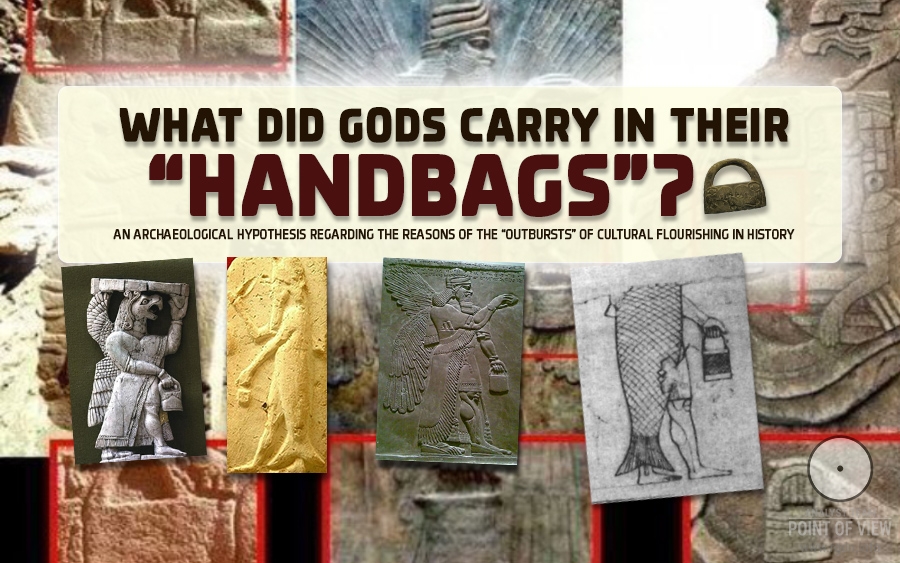by
Damien F. Mackey
“I add “Assyrian Apkallu” to the search parameters and even more images flood my screen. Often they show bearded men holding bags or buckets which closely resemble those depicted on the Göbekli Tepe pillar and the one held by the Mexican “Man in Serpent” figure”.
Graham Hancock
Knowing that Graham Hancock is never dull reading, and also that his recent (2015) book, Magicians of the Gods: The Forgotten Wisdom of Earth's Lost Civilisation, has quite a lot to say about Göbekli Tepe, a site whose findings I think are devastating for the evolutionary explanation of origins:
Göbekli Tepe dating plain wrong
then it was inevitable that I should, when I saw the book in a library, take it home to read.
A few things struck me early. Most especially, those ubiquitous ‘handbags’ of the gods.
What did they mean?
What function do ancient depictions of so-called hand bags have?...From the Olmec to Sumerian/Assyrian and even on a stela at Gobekli Tepe are these found..
Graham Hancock himself, when in situ at Göbekli Tepe, had speculated about these objects.
He writes about it in his book:
While I’m online I run some searches for images of the Seven Sages. I don’t get many hits at first, but the moment I change the search terms to “Apkallu” and “Seven Apkallu” I open a colossal archive of images from all over the internet, many of them reliefs from Assyria, a culture that thrived in Mesopotamia from approximately 2500 BC to about 600 BC. I add “Assyrian Apkallu” to the search parameters and even more images flood my screen. Often they show bearded men holding bags or buckets which closely resemble those depicted on the Göbekli Tepe pillar and the one held by the Mexican “Man in Serpent” figure. It’s not just the curved handles of these containers, or their shape—where the resemblance is much closer than on the original Oannes relief I reproduced in Fingerprints of the Gods. Even more striking is the peculiar and distinctive way that the figures from both Mesopotamia and Mexico hold these containers with the fingers of the hands turned inward and the thumb crooked forward over the handle.
There’s something else as well. A good number of the images show not a man but a therianthrope —a birdman with a hooked beak exactly like the hooked beak of the therianthrope on the Göbekli Tepe pillar. What makes the resemblance even closer is that in the Mesopotamian reliefs the birdman is holding the container in one hand and a cone-shaped object in the other. The shape is a little different but a comparison with the disc cradled above the wing of the Göbekli Tepe birdman is hard to resist.
I can’t prove anything yet. It could, of course, all be coincidence, or I could be imagining links that aren’t there. But my curiosity is aroused by the similar containers on different continents and in different epochs and so I jot down a series of questions that can form the frame of a loose hypothesis for future testing. For instance, could these containers (whether they are bags or buckets) be the symbols of office of an initiatic brotherhood—far traveled and deeply ancient, with roots reaching back into the remotest prehistory? I feel that this possibility, extraordinary though it may seem on the face of things, is worth looking into and is strengthened by the distinctive hand postures. Might these not have served the same sort of function as Masonic handshakes today—providing an instant means of identifying who is an “insider” and who is not?
[End of quote]
Striking cultural, architectural, and many other similarities amongst cultures spread as far and wide as Mesopotamia, Armenia (modern Turkey), Africa and the New World (e.g. Mexico), and significantly differing as to their eras, do not favour the evolutionary view of origins in isolation. How to explain this Göbekli Tepe–Australian Aboriginal connection, for instance?:
Also grabbing my attention in Hancock’s book were the ancient references to the Flood by Nebuchednezzar I and Ashurbanipal, especially given my identification of both of these names with Nebuchednezzar ‘the Great’ (so-called II) - three name for the one king. See e.g. my article:
Nebuchednezzar - mad, bad, then great
From these ancient quotes we learn that (also not favouring the evolutionary view) there was “the flood”, despite Mesopotamia often experiencing floods; that a “seed [was] preserved” from this flood, and that “writings” existed before the flood. Hancock writes:
In due course, later kings would speak of their link to the antediluvian world. In the late first millenium BC, Nebuchadnezzar I of Babylon described himself as a “seed preserved from before the flood”88 while Ashurbanipal, who ruled the central Mesopotamian empire of Assyria in the seventh century BC, boasted: “I learned the craft of Adapa, the sage, which is the secret knowledge … I am well acquainted with the signs of heaven and earth … I am enjoying the writings on stones from before the flood.”89

No comments:
Post a Comment